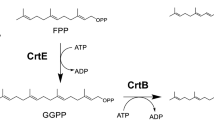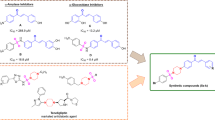Abstract
Santalenes and santalols from Santalum album are the main components of the valuable spice sandalwood essential oil, which also has excellent pharmacological activities such as antibacterial, anti-inflammatory, and antitumor. Firstly, we constructed biosynthesis pathways of santalenes by synthetic biology strategy. The assembled biosynthetic cassettes were integrated into the multiple copy loci of δ gene in S. cerevisiae BY4742 with assistance of pDi-CRISPR, and 94.6 mg/L santalenes was obtained by shake flask fermentation of engineered yeast. Secondly, a selected optimized P450-CPR redox system was integrated into the chromosome of the santalenes-producing strain with a single copy, and 24.6 mg/L santalols were obtained. Finally, the yields of santalenes and santalols were increased to 164.7 and 68.8 mg/L, respectively, by downregulating ERG9 gene. This is the first report on the de novo synthesis of santalols by P450-CPR chimera in S. cerevisiae. Meanwhile, the optimized chimeric CYP736A167opt-46tATR1opt exhibits higher activity to oxidize santalenes into santalols. It would provide a feasible solution for the optimal biosynthesis of santalols.
Key points
• First-time de novo synthesis of santalols by P450-CPR chimera in S. cerevisiae.
• Truncated 46tATR1 has higher activity than that of CPR2.
• Yields of santalenes and santalols were increased by downregulating ERG9 gene.







Similar content being viewed by others
Data availability
The datasets generated and analyzed during the current study are available from the corresponding author on reasonable request.
References
Bar-Even A, Salah Tawfik D (2013) Engineering specialized metabolic pathways-is there a room for enzyme improvements? Curr Opin Biotechnol 24:310–319. https://doi.org/10.1016/j.copbio.2012.10.006
Bernhardt R, Urlacher VB (2014) Cytochromes P450 as promising catalysts for biotechnological application: chances and limitations. Appl Microbiol Biotechnol 98:6185–6203. https://doi.org/10.1007/s00253-014-5767-7
Birkbeck AA (2017) The synthesis of fragrant natural products from Santalum album L.: (+)-(Z)-α-santalol and (–)-(Z)-β-santalol. Chim Int J Chem 71:823–835. https://doi.org/10.2533/chimia.2017.823
Bommareddy A, Rule B, Vanwert AL, Santha S, Dwivedi C (2012) α-Santalol, a derivative of sandalwood oil, induces apoptosis in human prostate cancer cells by causing caspase-3 activation. Phytomedicine 19:804–811. https://doi.org/10.1016/j.phymed.2012.04.003
Brocke C, Eh M, Finke A (2008) Recent developments in the chemistry of sandalwood odorants. Chem Biodivers 5:1000–1010. https://doi.org/10.1002/cbdv.200890080
Celedon JM, Chiang A, Yuen MMS, Diaz-Chavez ML, Madilao LL, Finnegan PM, Barbour EL, Bohlmann J (2016) Heartwood-specific transcriptome and metabolite signatures of tropical sandalwood (Santalum album) reveal the final step of (Z)-santalol fragrance biosynthesis. Plant J 86:289–299. https://doi.org/10.1111/tpj.13162
Chen DC, Yang BC, Kuo TT (1992) One-step transformation of yeast in stationary phase. Curr Genet 21:83–84. https://doi.org/10.1007/BF00318659
Chen Y, Daviet L, Schalk M, Siewers V, Nielsen J (2013) Establishing a platform cell factory through engineering of yeast acetyl-CoA metabolism. Metab Eng 15:48–54. https://doi.org/10.1016/j.ymben.2012.11.002
Di Girolamo A, Durairaj J, van Houwelingen A, Verstappen F, Bosch D, Cankar K, Bouwmeester H, de Ridder D, van Dijk ADJ, Beekwilder J (2020) The santalene synthase from Cinnamomum camphora: reconstruction of a sesquiterpene synthase from a monoterpene synthase. Arch Biochem Biophys 695:108647. https://doi.org/10.1016/j.abb.2020.108647
Diaz-Chavez ML, Moniodis J, Madilao LL, Jancsik S, Keeling CI, Barbour EL, Ghisalberti EL, Plummer JA, Jones CG, Bohlmann J (2013) Biosynthesis of sandalwood oil: Santalum album CYP76F cytochromes P450 produce santalols and bergamotol. PLoS ONE 8:e75053. https://doi.org/10.1371/journal.pone.0075053
Gibson DG (2011) Enzymatic assembly of overlapping DNA fragments. Methods Enzymol 498:349–361. https://doi.org/10.1016/B978-0-12-385120-8.00015-2
Gibson DG, Benders GA, Axelrod KC, Zaveri J, Algire MA, Moodie M, Montague MG, Venter JC, Smith HO, Hutchison CA (2008) One-step assembly in yeast of 25 overlapping DNA fragments to form a complete synthetic Mycoplasma genitalium genome. Proc Natl Acad Sci 105:20404–20409. https://doi.org/10.1073/pnas.0811011106
Jia D, Xu S, Sun J, Zhang C, Li D, Lu W (2019) Yarrowia lipolytica construction for heterologous synthesis of α-santalene and fermentation optimization. Appl Microbiol Biotechnol 3511–3520. https://doi.org/10.1007/s00253-019-09735-w
Jones CG, Moniodis J, Zulak KG, Scaffidi A, Plummer JA, Ghisalberti EL, Barbour EL, Bohlmann J (2011) Sandalwood fragrance biosynthesis involves sesquiterpene synthases of both the terpene synthase (TPS)-a and TPS-b subfamilies, including santalene synthases. J Biol Chem 286:17445–17454. https://doi.org/10.1074/jbc.M111.231787
Kennedy MA, Barbuch R, Bard M (1999) Transcriptional regulation of the squalene synthase gene (ERG9) in the yeast Saccharomyces cerevisiae. Biochim Biophys Acta - Gene Struct Expr 1445:110–122. https://doi.org/10.1016/S0167-4781(99)00035-4
Lograsso PV, Soltis DA, Boettcher BR (1993) Overexpression, purification, and kinetic characterization of a carboxyl-terminal-truncated yeast squalene synthetase. Arch Biochem Biophys 307:193–199. https://doi.org/10.1006/abbi.1993.1578
Lundemo MT, Woodley JM (2015) Guidelines for development and implementation of biocatalytic P450 processes. Appl Microbiol Biotechnol 99:2465–2483. https://doi.org/10.1007/s00253-015-6403-x
Misra BB, Dey S (2013) Culture of East Indian sandalwood tree somatic embryos in air-lift bioreactors for production of santalols, phenolics and arabinogalactan proteins. AoB Plants 5:1–10. https://doi.org/10.1093/aobpla/plt025
Ochi T, Shibata H, Higuti T, Kodama KH, Kusumi T, Takaishi Y (2005) Anti-Helicobacter pylori compounds from Santalum album. J Nat Prod 68:819–824. https://doi.org/10.1021/np040188q
Paulpandi M, Kannan S, Thangam R, Kaveri K, Gunasekaran P, Rejeeth C (2012) In vitro anti-viral effect of β-santalol against influenza viral replication. Phytomedicine 19:231–235. https://doi.org/10.1016/j.phymed.2011.11.006
Rani A, Ravikumar P, Reddy MD, Kush A (2013) Molecular regulation of santalol biosynthesis in Santalum album L. Gene 527:642–648. https://doi.org/10.1016/j.gene.2013.06.080
Renault H, Bassard JE, Hamberger B, Werck-Reichhart D (2014) Cytochrome P450-mediated metabolic engineering:current progress and future challenges. Curr Opin Plant Biol 19:27–34. https://doi.org/10.1016/j.pbi.2014.03.004
Sallaud C, Rontein D, Onillon S, Jabès F, Duffé P, Giacalone C, Thoraval S, Escoffier C, Herbette G, Leonhardt N, Causse M, Tissier A (2009) A novel pathway for sesquiterpene biosynthesis from Z, Z-farnesyl pyrophosphate in the wild tomato Solanum habrochaites. Plant Cell 21:301–317. https://doi.org/10.1105/tpc.107.057885
Santha S, Dwivedi C (2013) α-Santalol, a skin cancer chemopreventive agent with potential to target various pathways involved in photocarcinogenesis. Photochem Photobiol 89:919–926. https://doi.org/10.1111/php.12070
Scalcinati G, Knuf C, Partow S, Chen Y, Maury J, Schalk M, Daviet L, Nielsen J, Siewers V (2012) Dynamic control of gene expression in Saccharomyces cerevisiae engineered for the production of plant sesquitepene α-santalene in a fed-batch mode. Metab Eng 14:91–103. https://doi.org/10.1016/j.ymben.2012.01.007
Sciarrone D, Costa R, Ragonese C, Tranchida PQ, Tedone L, Santi L, Dugo P, Dugo G, Joulain D, Mondello L (2011) Application of a multidimensional gas chromatography system with simultaneous mass spectrometric and flame ionization detection to the analysis of sandalwood oil. J Chromatogr A 1218:137–142. https://doi.org/10.1016/j.chroma.2010.10.117
Sharma M, Levenson C, Clements I, Castella P, Gebauer K, Cox ME (2017) East Indian Sandalwood Oil (EISO) alleviates inflammatory and proliferative pathologies of psoriasis. Front Pharmacol 8:1–13. https://doi.org/10.3389/fphar.2017.00125
Shi S, Liang Y, Zhang MM, Ang EL, Zhao H (2016) A highly efficient single-step, markerless strategy for multi-copy chromosomal integration of large biochemical pathways in Saccharomyces cerevisiae. Metab Eng 33:19–27. https://doi.org/10.1016/j.ymben.2015.10.011
Solomon KV, Sanders TM, Prather KLJ (2012) A dynamic metabolite valve for the control of central carbon metabolism. Metab Eng 14:661–671. https://doi.org/10.1016/j.ymben.2012.08.006
Srivastava PL, Daramwar PP, Krithika R, Pandreka A, Shankar SS, Thulasiram HV (2015) Functional characterization of novel sesquiterpene synthases from Indian Sandalwood, Santalum album. Sci Rep 5:1–12. https://doi.org/10.1038/srep10095
Teixeira da Silva JA, Kher MM, Soner D, Page T, Zhang X, Nataraj M, Ma G (2016) Sandalwood: basic biology, tissue culture, and genetic transformation. Planta 243:847–887. https://doi.org/10.1007/s00425-015-2452-8
Urban P, Mignotte C, Michae¨ l Kazmaier, Delorme F, Pompon D, (1997) Cloning, yeast expression, and characterization of the coupling of two distantly related Arabidopsis thaliana NADPH-cytochrome P450 reductases with P450 CYP73A5. J Biol Chem 272:19176–19186. https://doi.org/10.1074/jbc.272.31.19176
Xie W, Ye L, Lv X, Xu H, Yu H (2015) Sequential control of biosynthetic pathways for balanced utilization of metabolic intermediates in Saccharomyces cerevisiae. Metab Eng 28:8–18. https://doi.org/10.1016/j.ymben.2014.11.007
Yan X, Fan Y, Wei W, Wang P, Liu Q, Wei Y, Zhang L, Zhao G, Yue J, Zhou Z (2014) Production of bioactive ginsenoside compound K in metabolically engineered yeast. Cell Res 24:770–773. https://doi.org/10.1038/cr.2014.28
Yin JL, Wong WS (2019) Production of santalenes and bergamotene in Nicotiana tabacum plants. PLoS ONE 14:1–16. https://doi.org/10.1371/journal.pone.0203249
Yuan J, Ching CB (2015) Dynamic control of ERG9 expression for improved amorpha-4,11-diene production in Saccharomyces cerevisiae. Microb Cell Fact 14:1–10. https://doi.org/10.1186/s12934-015-0220-x
Zha W, An T, Li T, Zhu J, Gao K, Sun Z, Xu W, Lin P, Zi J (2020) Reconstruction of the biosynthetic pathway of santalols under control of the gal regulatory system in yeast. ACS Synth Biol 9:449–456. https://doi.org/10.1021/acssynbio.9b00479
Zhan X, Zhang Y-H, Chen D-F, Simonsen HT (2014) Metabolic engineering of the moss Physcomitrella patens to produce the sesquiterpenoids patchoulol and α/β-santalene. Front Plant Sci 5:1–10. https://doi.org/10.3389/fpls.2014.00636
Zhang D, Jennings SM, Robinson GW, Poulter CD (1993) Yeast squalene synthase: expression, purification, and characterization of soluble recombinant enzyme. Arch Biochem Biophys 304:133–143. https://doi.org/10.1016/S0022-3093(00)00296-9
Zhang F, An T, Tang X, Zi J, Bin LH, Wu R (2020) Enzyme promiscuity versus fidelity in two sesquiterpene cyclases (TEAS versus ATAS). ACS Catal 10:1470–1484. https://doi.org/10.1021/acscatal.9b05051
Funding
This work was supported by the National Natural Science Fund 31760189, Yunnan Bao Shan 7th Batch Technological Innovation Talents Project 201805.
Author information
Authors and Affiliations
Contributions
W.M.L, H.X.L., and W.Y.C. conceived and designed the study. G.X.W did the gas chromatography mass spectrometry measurements. W.Y.C., L.F., and Z.S.S. conducted experiments in lab. L.M.G. and Z.J.Y. analyzed the data. W.Y.C. wrote the initial manuscript. H.X.L. and W.M.L. edited the manuscript. All authors read and approved the manuscript.
Corresponding authors
Ethics declarations
Ethics approval
This article does not contain any studies on human volunteers or animals.
Conflict of interest
The authors declare no competing interests.
Additional information
Publisher’s note
Springer Nature remains neutral with regard to jurisdictional claims in published maps and institutional affiliations.
Supplementary Information
Below is the link to the electronic supplementary material.
Rights and permissions
About this article
Cite this article
Wang, Y., Gong, X., Li, F. et al. Optimized biosynthesis of santalenes and santalols in Saccharomyces cerevisiae. Appl Microbiol Biotechnol 105, 8795–8804 (2021). https://doi.org/10.1007/s00253-021-11661-9
Received:
Revised:
Accepted:
Published:
Issue Date:
DOI: https://doi.org/10.1007/s00253-021-11661-9




